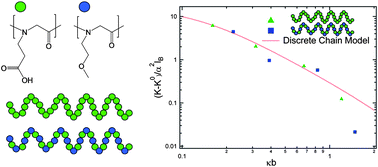Persistence length of polyelectrolytes with precisely located charges†
Abstract
The conformation of polyelectrolytes in aqueous salt solutions is closely related to their

* Corresponding authors
a
Department of Chemical and Biomolecular Engineering, University of California, Berkeley, CA 94720, USA
E-mail:
segalman@berkeley.edu
b Institute of Materials Science, University of Connecticut, Storrs, Connecticut 06269, USA
c Molecular Foundry, Lawrence Berkeley National Laboratory, Berkeley, CA 94720, USA
The conformation of polyelectrolytes in aqueous salt solutions is closely related to their

 Please wait while we load your content...
Something went wrong. Try again?
Please wait while we load your content...
Something went wrong. Try again?
H. K. Murnen, A. M. Rosales, A. V. Dobrynin, R. N. Zuckermann and R. A. Segalman, Soft Matter, 2013, 9, 90 DOI: 10.1039/C2SM26849C
To request permission to reproduce material from this article, please go to the Copyright Clearance Center request page.
If you are an author contributing to an RSC publication, you do not need to request permission provided correct acknowledgement is given.
If you are the author of this article, you do not need to request permission to reproduce figures and diagrams provided correct acknowledgement is given. If you want to reproduce the whole article in a third-party publication (excluding your thesis/dissertation for which permission is not required) please go to the Copyright Clearance Center request page.
Read more about how to correctly acknowledge RSC content.
 Fetching data from CrossRef.
Fetching data from CrossRef.
This may take some time to load.
Loading related content
